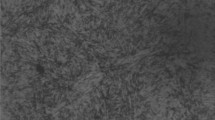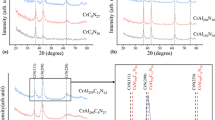Abstract
Metallographic preparation of thermal spray coated samples is often difficult because hard and soft materials, which normally require different polishing techniques, are commonly present in a single spraycoated sample. In addition, the microstructures of many spray- deposited materials make them prone to pull-out damage during cutting, grinding, and polishing operations. This study compares alternative metallographic techniques to prepare three common types of thermal sprayed coatings: (1) a plasma sprayed alumina-titania wear coating, (2) a plasma sprayed zirconia thermal barrier coating, and (3) a high-velocity oxy-fuel (HVOF) sprayed tungsten- carbide/cobalt (WC/Co) hard coating. Each coating was deposited onto a steel substrate and was prepared with metallographic protocols based on silicon carbide (SiC) papers, bonded diamond platens, and diamond slurries. Polishing with SiC papers generally produced edge rounding and significant pull- out, which increased the apparent porosity of the coatings. Polishing with bonded diamond platens produced less edge rounding, but some pull- out was still observed. Preparation by diamond slurry lapping consistently produced the best overall results. Porosity artifacts produced by polishing with SiC papers and bonded diamond platens also resulted in spuriously low hardness values for the WC/Co samples; however, hardness results for the two ceramic coatings were not affected by the polishing method.
Similar content being viewed by others
References
J. Ilarsky, C.C. Berndt, H. Herman, J. Forman, J. Dubsky, P. Chraska, and K. Neufuss, Analysis of Porosity of Free-Standing Ceramics Manufactured by Plasma Spraying,Thermal Spray Coatings: Research,Design, and Applications, C.C. Bemdt and T.F. Bernecki, Ed., ASM International, 1993, p 505–511
R. Kawase, Evaluation Methods for Thermal Spray Coatings,Thermal Spray Coatings: Research, Design, and Applications, C.C. Berndt and T.F. Bernecki, Ed., ASM International, 1993, p 575–579
R. Dal Maschio, V.M. Sgavo, F. Rigoni, L. Bertamini, and E. Galvenetto, Measurement of Metal-Ceramic Adhesion by Indentation Technique in Thick TBC’s,Thermal Spray: International Advances in Coatings Technology, C.C. Berndt, Ed., ASM International, 1992, p 947–951
G.A. Blann, The Important Role of Microstructural Evaluation in Each Phase of Thermally Sprayed Coatings Application,Thermal Spray: International Advances in Coatings Technology, C.C. Berndt, Ed., ASM International, 1992, p 959–966
G.F. Vander Voort,Metallography Principals and Practice, McGraw-Hill, 1984
L.E. Samuels,Metallographic Polishing by Mechanical Methods, 3rd ed., ASM International, 1982
Author information
Authors and Affiliations
Rights and permissions
About this article
Cite this article
Smith, M.F., McGuffin, D.T., Henfling, J.A. et al. A comparison of techniques for the metallographic preparation of thermal sprayed samples. JTST 2, 287–294 (1993). https://doi.org/10.1007/BF02650478
Issue Date:
DOI: https://doi.org/10.1007/BF02650478




